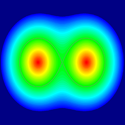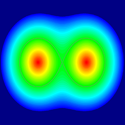Spin-polarized positronium
Positronium ( ) is a short-lived “atom” that consists of an electron bound to its antiparticle, the positron. Positron beams derived from radioactive sources are always spin-polarized to some extent, and have been used for a variety of applications, for instance measuring the magnetic properties of ferromagnets, and studying fundamental interactions. It has been known for some years now that fully spin-polarized positronium beam, if produced at high enough densities, is also, due to its low mass, a very good candidate for observing Bose condensation in a positronium system, with well-defined interactions between the constituents and a reasonably high condensation temperature. A positronium Bose condensate is a necessary precursor for observing stimulated annihilation and the (as yet) unrealized gamma-ray laser.
Writing in Physical Review Letters, David Cassidy, Vincent Meligne, and Allen Mills, Jr., from the University of California, Riverside, US, have demonstrated a way to destroy the minority spin atoms in a high-density collection of positronium atoms, leaving a fully spin-polarized gas. In this experiment, atoms interact with each other in porous silica films in a magnetic field and diffuse between the interconnected voids, resulting in a selective quenching of the minority states. In addition, Cassidy et al. show that the initial positron polarization is preserved in an intermediate accumulation process that uses a buffer gas trap. The present method produces a density that is still two orders of magnitude lower than that needed to achieve Bose-Einstein condensation, but it overcomes an important hurdle. – Sarma Kancharla





